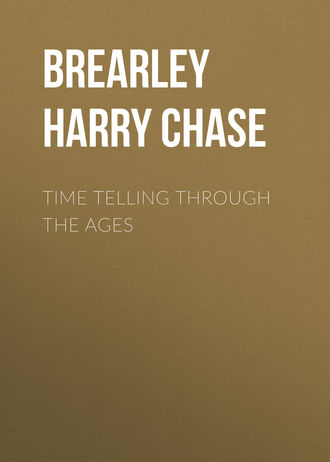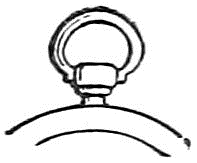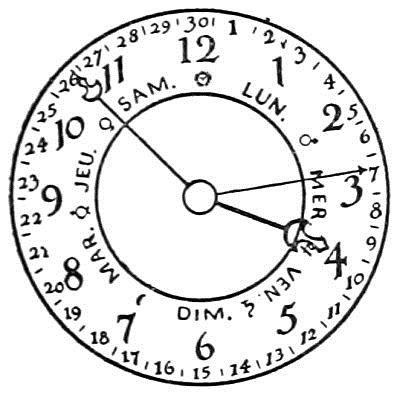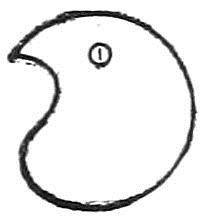 полная версия
полная версияTime Telling through the Ages
APPENDIX D
Well-Known Watch Collections
(From list compiled by Major Paul M. Chamberlain, of Chicago in 1915.)Abbott – George E. H. Abbott, Groton, Massachusetts.
Addington – S. Addington, Esq., purchaser at Bernal sale.
Ashmolean – Ashmolean Museum, Oxford, England.
Augsburg – Maxmillian Museum, Augsburg, Germany.
Baker – Edwin P. Baker, referred to by Britten.
Baxter – James Phinney Baxter, Portland, Maine.
Blois – Musee de la ville, Blois, France.
Boston – Museum of Fine Arts, Boston, Massachusetts.
Bourne – T. W. Bourne, referred to by Britten.
British – British Museum, London, England.
Bulley – Edward H. Bulley, referred to by Britten.
Burkhardt – M. Albert Burkhardt, Basle, Switzerland.
Chamberlain – Paul M. Chamberlain, Chicago, Illinois.
Chesam – Lord Chesam, referred to by Britten.
Cluny – Musee de Cluny, Paris, France.
Clarke – A. E. Clarke, London, England.
Cockey – Edward C. Cockey, New York City.
Cointre – La Famille Cointre, of Poitiers, France.
Copenhagen – Horological Museum, Copenhagen, Denmark.
Cook – E. E. Cook, Walton-on-Thames, England.
Czar – Imperial collection, Hermitage Gallery, Petrograd, Russia (1915).
Cumberland – Duke of Cumberland, England.
Debruge – Debruge collection, catalogue published in 1849, referred to by M. E. Deville in Les Horlogers Blesois.
Dennison – Franklin Dennison collection, Birmingham, England.
Devotion – The Edward Devotion House, Brookline, Massachusetts.
Dickson – R. Eden Dickson, London, England.
Ditisheim – Henri Ditisheim, Chaux-de-Fonds, Switzerland.
Dresden – Green Vaulted Chambers, Dresden, Germany.
Duplessis – Family of Duplessis of Blois, referred to in Les Horlogers Blesois.
Dover – Dover Museum, Dover, England.
Dunwoody – Dr. W. J. Dunwoody, mentioned by Britten.
Estreicher – Dr. Tad. Estreicher, Fribourg, Switzerland.
Eschenbach – Baroness Marie von Ebner-Eschenbach, Vienna, Austria-Hungary.
Fawkes – J. H. Fawkes of Farnlet Hall, England.
Fellows – Collection of Sir Charles Fellows, of Westbourn, Isle of Wight, bequeathed by widow to British Museum.
Fitzwilliam – Fitzwilliam Museum, Cambridge, England.
Fleisher – Collection of Moyer Fleisher, exhibited in the Pennsylvania Museum,
Memorial Hall, Philadelphia, Pennsylvania.
Foulc – M. Foulc, Paris, France.
Franck – B. Bernard Franck, Paris, France.
Freeman – Charles Freeman, referred to by Britten.
Froidevaux – M. Froidevaux, Blois, France.
Garnier – M. Paul Garnier, Paris, France.
Gelis – M. Edouard Gelis, Paris, France.
Geyer – H. F. Geyer, mentioned by Britten.
Georgi – M. Georgi, Paris, France.
Glyn – George Carr Glyn, referred to by Britten.
Gotha – Museum of Gotha, Germany.
Greene – T. Whitcomb Greene, referred to by Britten.
Guildhall – Guildhall Museum, London, England.
Hartshorne – Albert Hartshorne, referred to by Britten.
Hearn – George Hearn collection, presented by widow to Metropolitan Museum of Art, New York City.
Heckscher – Martin Heckscher collection in Vienna, Austria-Hungary.
Heinz – Collection of Henry J. Heinz, exhibited in the Carnegie Museum, Pittsburg.
Hodgkins – Collection of J. E. Hodgkins, London, England.
Humphreys – Miss M. Humphreys, mentioned in Britten.
Jenkins – Collection of Jefferson D. Jenkins, Decatur, Illinois.
King – C. King, Newport, Monmouthshire, England.
Kensington – South Kensington Museum, London, England.
Kirner – B. A. Kirner, Chicago, Illinois.
Lambert – Messrs. Lambert, referred to by Britten.
Lazerus – Collection of Moses Lazerus, Philadelphia, bequeathed to Pennsylvania Museum, Philadelphia, Pennsylvania.
Lambiley – Compte de Lambiley, France.
Laurance – E. A. Laurance, mentioned by Britten.
Lebenheim – Mentioned in Morgan catalogue.
Lecointre – Family of Lecointre, Poitiers, France.
Leicester – Leicester Museum, Leicester, England.
Leroux – M. E. Leroux, Paris, France.
Liljigren – L. O. Liljigren, Chicago, Illinois.
Londesboro – Lord Londesboro, London, England.
Louvre – Musee de Louvre, Paris, France.
Marfels – Collection of Carl Marfels, Berlin, Germany.
Massey – Edwards Massey, London, England.
Meldrum – Robert Meldrum, referred to by Britten.
Metropolitan – Metropolitan Museum of Art, New York City.
Mirabaud – M. G. Mirabaud, Paris, France.
Moore – Bloomfield Moore collection in Pennsylvania Museum, Philadelphia.
Morgan – J. Pierpont Morgan collection at Metropolitan Museum of Art, New York City.
O. Morgan – Octavius Morgan collection in British Museum.
Moray – Lord Moray, London, England.
Moss – Rev. J. J. Moss, purchaser at Bernal sale, London, England, 1855.
Munich – National Bavarian Museum at Munich, Germany.
Nelthropp – Collection presented by Rev. H. L. Nelthropp to the Worshipful Company of Clockmakers of the City of London and exhibited at Guild Hall Museum.
Newington – Newington Free Library, Newington, England.
Olivier – M. Olivier, Paris, France.
Parr – Edward Parr, London, England.
Partridge – R. W. Partridge, London, England.
Ponsonby – Hon. Gerald Ponsonby, referred to by Britten.
Proctor – Frederick Towne Proctor, Utica, New York.
Proctor, T. R. – Thomas Redfield Proctor, Utica, New York.
Purnell – J. B. Purnell, purchaser at Bernal sale in 1855.
Ranken – William Ranken, London, England.
Reeves – R. F. Reeves, St. Louis, Missouri.
Renouard – Family of Renouard, Belois, France.
Roberts – Evan Roberts, London, England.
Robertson – J. Drummond Robertson, London, England.
Roblot – Ch. Roblot, Paris – Passy, France.
Rothchild – Baroness Alphonse de Rothchild collection.
Rosenheim – Max Rosenheim, referred to by Britten.
Roux – Edward Roux, mentioned by Britten.
Salting – Collection now in the South Kensington Museum.
Saussure – M. Th. de Saussure, mentioned by Britten.
Sauve – M. Sauve, Belois, France.
Schlichting – Baron von Schlichting, Petrograd, Russia, (1915).
Shapland – Charles Shapland, London, England.
Shaw – Morgan Shaw, London, England.
Sidebottom – Collection of Mrs. H. Sidebottom, in South Kensington Museum.
Sivan – M. Charles Sivan, Paris, France.
Smythies – Major R. H. Raymond Smythies, London, England.
Soane – Soane Museum, London, England.
Stamford – Stamford Institution, England.
Stroehlin – Stroehlin collection, referred to in J. P. Morgan catalogue.
Sudell – Edward Sudell, mentioned by Britten.
Sutton – Rev. A. F. Sutton, England.
Thompson – Mrs. G. F. Thompson, Ottawa, Canada.
Torphicon – Lord Torphicon, referred to by Britten.
Turrettini – Turrettini collection referred to by Dr. Williamson in Morgan catalogue.
Vautier – M. L. Vautier, Belois, France.
Vendome – Calvaire de Vendome, France.
Vienna – Imperial Treasury, Vienna, Austria-Hungary.
Wallace – Lord Wallace collection, bequeathed by his widow to the British Museum.
Wehrle – Eugene Wehrle, Brussels, Belgium.
Wheeler, H. L. – Horace L. Wheeler, Boston, Massachusetts.
Wheeler – Collection of Willard H. Wheeler, Brooklyn, N. Y., exhibited in the Brooklyn Museum, New York City.
APPENDIX E
Encyclopedic Dictionary
Abrasion – Wearing away by rubbing or friction.
Adams, J. C. – A promoter instrumental in organizing the Elgin, Illinois, Cornell, and Peoria Watch Companies, and the Adams & Perry Manufacturing Company. He invented and patented the "Adams System" of time records in use on most of the railroads in the West. He last appeared in prominent connection with the watch and clock business as the organizer of the Swiss horological exhibit at the World's Columbian Exposition.
Addenda – Tips of the teeth of a wheel beyond the pitch circle. Sometimes of circular outline; sometimes ogive – that is, of a shape patterned after the pointed arch. The addendum is also known as the "face" of the tooth.
Adjustment – The manipulation of the balance with its spring and staff to secure the most accurate time-keeping possible. Three adjustments are usually made, viz.: for isochronism, temperature and position. Much of the difference in value and cost of watches depends on this operation.
Adjustment to Isochronism – Strictly speaking this would cover all adjustment; but it is technically understood to mean an adjustment of the balance spring so that the time of vibration through the long and short arcs of the balance is the same.
Adjustment to Positions – The manipulation of the balance and its spring so that a watch keeps time in different positions. Good watches are usually adjusted to five positions. They are pendant up; III up; IX up; dial up; and dial down.
Adjustment to Temperature or Compensation – The adjustment of the balance and spring so that the time-keeping qualities are affected as little as possible by changes in temperature. See Compensation.
Ahaz – King of Judea, 742-727 B. C. See Dial of Ahaz.
Alarm – Sometimes spelled "alarum." A mechanism attached to a clock whereby at any desired time a bell is struck rapidly by a hammer.
Aluminum-Bronze – An alloy of aluminum and pure copper, usually in the proportion of 10 parts of the former and 90 of the latter. It is considerably lighter than brass and highly resistant to wear.
Anaximander – Greek astronomer to whom the Greeks ascribed the invention of the sun-dial in the sixth century B. C.
Arbor – The axle or axis on which a wheel of a watch or clock turns. Also applied to a spindle used by watchmakers.
Arc – Any section of the circumference of a circle.
Archimedes – A famous Greek philosopher and scientist sometimes credited with the invention of the clock. About 200 B. C. he made a machine with wheel work and a maintaining power but having no regulator it was no better as a time teller than a planetarium turned by a handle. It may have furnished the suggestion for later time-keeping machines.
Arnold, John – Born 1736. An English watchmaker of note. He invented the helical form of the balance spring and a form of chronometer escapement much like Earnshaw's. Died 1799. Arnold's devices have been most useful and permanent.
Assembling – The putting together of the finished parts of a watch. In a three-quarter plate watch this is done on the lower plate. In a full plate movement it is easier and more satisfactory to assemble on the top plate.
Astrolabe – 1. An instrument of various forms formerly used especially in navigation to measure the altitudes of planets and stars. 2. A projection of a sphere upon any of its great circles.
Astronomical Time – Means solar time, as computed from observing the passage of the sun across the meridian from noon of one day to noon of the following day. It is counted continuously up to 24 – not in two 12-hour divisions.
Astronomy – The science which treats of the motions, real and apparent, of the heavenly bodies. Upon this science, through its determination of the length of the year, is founded the science of horology – or time-keeping.
Automata – for Striking – Very common on old clocks and very complicated, such as: Indian King hunting with elephants, Adam and Eve, Christ's flagellation, and many others. See Clocks, Interesting Old.
Automatic Machinery – The second great contribution of America to watchmaking after the establishment of the principle of interchangeability of parts, and making possible the effective execution of that principle.
Auxiliary – A device attached to a compensation balance to reduce what is known as the "middle temperature error." Some are constructed to act in high temperatures only – as Molyneux's; and some in low temperatures only – as Poole's.
Balance – The vibrating wheel in a watch or chronometer which with the aid of the balance spring (hair-spring) regulates the rate of travel of the hands. The balance is kept in vibration by means of the escape wheel. See Compensation Balance.
Balance Arc – In detached escapements, that part of the vibration of the balance in which it is connected with the train. The remainder is called the drop.
Balance-Clock – A form of clock built before the pendulum came into use. The regulating medium was a balance on the top of the clock made with a verge escapement. See Foliot.
BALANCE COCK
Balance Cock – The standard which supports the top pivot of the balance. In old watches often elaborately pierced and engraved.
Balance Spring – In America usually called the "hair-spring." A long slender spring that governs the time of vibration of the balance. One end of the balance spring is fastened to a collet fitted friction-tight on the balance staff, the other to a stud attached to the balance cock or to the watch plate. The most ordinary form is the volute, or flat spiral. The other form used is an overcoil. See Bréquet Spring. The principle of the isochronism of a balance spring was discovered by Hooke, and first applied to a watch by Tompion. The name hair-spring comes from the fact that the first ones are said to have been made from hog bristles.
Balance Spring Buckle or "Guard" – A small stud with a projecting tongue attached to the index arm and bridging the curb pins so as to prevent their engaging two of the balance spring coils. Used chiefly in Swiss watches.
Balance Staff – The axis of the balance. The part of a watch most likely to be injured by a fall.
Balance Wheel – A term often incorrectly applied to the balance itself, but properly it is the escape wheel of the verge escapement.
Band – Of a Watchcase – The "middle" of the case to which the dome, bottom and bezel are fastened; the last sometimes screwed, sometimes snapped.
Bank – Banking-pin.
Banking – In a lever watch the striking of the outside of the lever by the impulse pin due to excessive vibration of the balance. In a cylinder or verge movement the striking of the pin in the balance against the fixed banking-pin.
Banking-Pin – A pin for restricting the motion of the balance in verge and cylinder watches.
Banking-Pins – 1. In a lever watch, two pins which limit the motion of the lever. 2. In a pocket chronometer, two upright pins in the balance arm which limit the motion of the balance spring. 3. In any watch, the curb pins which confine the balance spring are sometimes called banking-pins.
Barlow, Edward (Booth) – A clergyman of the Church of England, born in 1636. He devoted a great deal of time to horological pursuits. He invented the rack repeating striking works for clocks, applied by Tompion in 1676. He invented also a repeating works for watches on the same plan. And he invented the cylinder escapement which he patented with Tompion and Houghton. When he applied for a patent on his repeating watch he was successfully contested by Quare, who was backed by the Clockmakers' Company. He died in 1716.
Bar Movement – A watch movement in which bars take the place of the top plate and carry the upper pivots. Sometimes termed a "skeleton" movement. Not generally adopted because its many separate bearing parts promote inaccuracies where large quantities are to be produced.
Barrel – A circular box which confines the mainspring of a watch or clock.
Barrel Arbor – The axis of the barrel around which the mainspring is coiled.
Barrel Hollow – A sink cut either into the top plate or the pillar plate of a watch to allow the barrel freedom.
Barrel Hook – A bent pin in the barrel to which the mainspring is attached.
Barrel Ratchet – A wheel on the barrel arbor which is prevented by a dog from turning backward while the mainspring is being wound and which becomes the base against whose resistance the train is driven.
Bartlett, P. S. – One of the early watchmakers of America. Connected with the Waltham factory at first and later with the Elgin Company. It is said that he first proposed the formation of the company at Elgin. His name became familiar as a household word throughout the country from being inscribed upon a full-plate model which attained widespread success.
Beat – The strike or blow of the escape wheel upon the pallet or locking device.
Beat Pins – The pins at the ends of the pallets in a gravity escapement which give impulse to the pendulum.
Beckett, Sir Edmund – See Denison, Edmund Beckett.
Berosus – A Chaldean historian who lived at the time of Alexander the Great, about 200 B. C., and was a priest of Belus at Babylon. Said to have been the inventor of the hollow sun-dial. He was the great astronomer of his age.
Berthoud, Ferdinand, 1727-1807 – An eminent French watchmaker and writer on horological subjects. Among his books are: "Essai sur l'Horlogerie," "Traite des Horloges Marines," and "Histoire de la mesure du Temps." He was a Swiss by birth, but lived most of his life in Paris.
Bezel – The ring of a watch or clock case which carries the glass or crystal in an internal groove.
Big Ben – The great bell which strikes the hours on the clock at Westminster.
Bizzle – A corruption of Bezel. See Bezel.
Blow Holes – Places where the brass and steel of a compensation balance are not perfectly united, when they are put together with silver or solder.
Bob – The metal mass forming the body of a pendulum.
Boethius, Ancius Manlius Severinus, A. D. 480-524 – A Roman philosopher and statesman to whom is sometimes attributed the invention of the clock. He did make a sun-dial and a water clock which latter may have contained a germ of the idea later developed into our modern clock.
Boss – A cylindrical prominence or stud. The minute hand is carried on the boss of the center wheel.
Bottom – Of a Watchcase – The cover outside the dome of the case. Commonly called the "back."
Bouchon – The hard brass tubing of which pivot holes in watch and clock plates are made; known commonly as "bushing wire." The short sections cut off for a pivot being called the "bushing."
Bow – The ring of a watch case to which the guard or chain is attached; also known as "pendant bow."

BOW AND BUTTON
Box Chronometer – A marine chronometer.
Boxing-In – Fitting the watch movement in its case; applied chiefly to the encasing of stem-winding movements.
Bréquet, Abraham Louis – A celebrated Swiss mechanician and watchmaker born at Neufchatel in 1747. He made several improvements in watches, the most notable being the Bréquet hairspring still in use in the best watches. He died in 1823.

BRÉQUET SPRING
Bréquet Spring – A form of balance spring which is a volute with its outer end bent up above the plane of the body of the spring and carried in a long curve towards the center near which it is fixed. Like all other springs in which the outer coil returns towards the center, it offers opportunities of obtaining isochronism by varying the character of the curves described by the outer coil and thus altering its resistance. So-called from its inventor, Abraham Louis Bréquet (q. v.). Its advantage over the flat spring is that the overcoil allows expansion and contraction in all directions, thereby avoiding a good deal of side friction on the pivots as well as insuring more nearly perfect isochronism in changes of temperature.
Bridge – A standard fastened to the plate, in which a pivot works.
Bridge Model – The term given to watch movements in which plates or bridges carrying the upper pivots of the train rest firmly on the lower or dial plate and are held rigid by steady pins on lower side of the plate; the bridge being secured direct to the dial plate by screws termed plate or bridge screws. This is the most common construction of present-day manufacture and is utilized in three-quarter plate or separate and combination bridges covering one or more pivots of train wheels. Its alternate is "pillar model."
Buck, D. A. A. – A watch repairer in Worcester, Mass., who designed a model for the Waterbury watch. His first model was not successful, but in 1877 he completed one which, a little later, the Waterbury Company, with Buck as master watchmaker, started to make. He remained with the company until 1884.
Bush – A perforated piece of metal let into a plate to receive the wear of pivots.
Butting – The engaging of the tips of the teeth of two wheels acting in gear. The proper point of contact being in the line of the shoulders of the teeth, butting is remedied by setting the wheels farther apart.
Button – The milled knob used for winding and setting a keyless watch.
Calculagraph – Trade name for a device for automatically computing and recording elapsed time in connection with factory jobs and other work where it is necessary to show the amount of labor used.
Calendar – A system of dividing the year into months and days. The principal calendars known to history are: the Julian calendar; the Gregorian calendar; the Hebrew calendar; the Mohammedan calendar; and the Republican calendar. None of them has been quite accurate in dividing up the solar year, and frequent arbitrary corrections are necessary to secure a practical approximation. See descriptive article under each title.
Julian– Established by Julius Caesar, 46 B. C., to remedy existing defects in the Roman calendar then in use. The Julian year was based on the assumption that the solar year is 365¼ days – which was 11 minutes and 14 seconds too long. The scheme adopted was to make the regular calendar year 365 days, and to add one day every fourth year. The Julian calendar is still in use by Russia and Greece, where the dates now differ from those of most other countries by 13 days.
Gregorian– Established October 15, 1582, by Pope Gregory XIII, in correction of the obvious errors of the Julian calendar. It is the calendar now in use by nearly all civilized nations. The mean length of the Gregorian year is 365 days, 5 hours, 49 minutes and 12 seconds – 26 seconds longer than the actual solar year. Correction is made by adding a 29th day for February every fourth year, excepting when the date of said fourth year is divisible by 100. If, however, the date is also divisible by 400, the extra day is added.
Republican– The calendar of the French Revolution (1793) declared to begin at midnight on the meridian of the Paris Observatory preceding the true autumnal equinox, September 22, 1792. There were 12 months of 30 days each and 5 or 6 "extra days" (as might be necessary) at the end of the year to bring the new year nearest to the then position of the equinox. Abolished January 1, 1806.
Hebrew– Composed of 12 lunar months, a thirteenth month being added from time to time to secure correspondence of the months with the passing seasons. The months are arbitrarily arranged to have alternately 29 days and 30 days. The length of the calendar year varies from 353 days to 385 days.
Mohammedan– Based on a lunar year of 354 days divided into 12 lunar months which are alternately 29 and 30 days in length. During each period of 30 years a total of 11 days are added one at a time at the end of a year. The lack of co-ordination with the solar year results in a total separation of the seasonal year and the calendar year. In use in Turkey and some other Mohammedan countries.

CALENDAR CLOCK
Calendar Clock, or Watch – A clock or watch which indicates days and months as well as hours.
Caliper – The scheme of arrangement of a watch train, or the disposition of the parts of a watch.

CAM
Cam – A rotating piece either non-circular or eccentric, used to convert rotary into linear reciprocating motion, oftener irregular in direction, rate, or time.
Cannon Pinion – The pinion to which the minute hand is attached. It is tubular in form (whence its name), the main arbor passing through it friction-tight.

